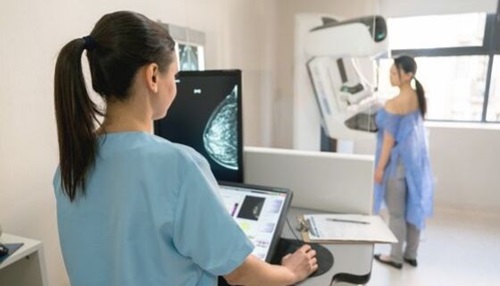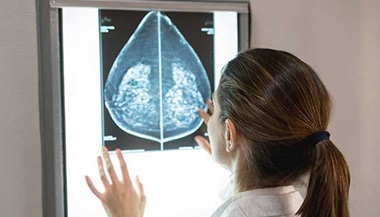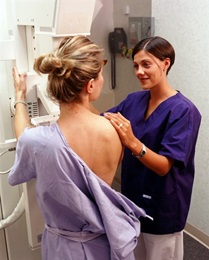Mammogram Procedure
What is a mammogram?
A mammogram is an X-ray examination of the breast. It is used to detect and diagnose breast disease in women who either have breast problems, such as a lump, pain, or nipple discharge, as well as for women who have no breast complaints. The procedure allows detection of breast cancers , benign tumors, and cysts before they can be detected by palpation (touch).
Mammography cannot prove that an abnormal area is cancer, but if it raises a significant suspicion of cancer, tissue will be removed for a biopsy . Tissue may be removed by needle or open surgical biopsy and examined under a microscope to determine if it is cancer.
Mammography has been used for about 30 years, and in the past 15 years technical advancements have greatly improved both the technique and results. Today, dedicated equipment, used only for breast X-rays, produces studies that are high in quality, but low in radiation dose. Radiation risks are considered to be negligible.
.png?h=200&iar=0&mh=360&mw=520&w=200&hash=97830FA4D9AAC1E294EA0E63AC743BBA)
The development of digital mammography technology allows for improved breast imaging, in particular, for women less than 50 years of age, women with dense breast tissue, and women who are premenopausal or perimenopausal. Digital mammography provides electronic images of the breasts that can be enhanced by computer technology, stored on computers, and even transmitted electronically in situations where remote access to the mammogram is required. The procedure for a digital mammography is basically performed the same way as a standard mammogram.
With computer-aided detection (CAD) systems, a digitized mammographic image from a conventional film mammogram or a digitally acquired mammogram is analyzed for masses, calcifications, or areas of abnormal density that may indicate the presence of cancer. The images are highlighted by the CAD system for further analysis by the radiologist.
.png?h=200&iar=0&mh=360&mw=520&w=200&hash=39F4F45102DFBC3CE678EE0F8EEB40FD)
What are the different types of mammograms?
According to the National Cancer Institute:
-
Screening mammogram. A screening mammogram is an X-ray of the breast used to detect breast changes in women who have no signs or symptoms of breast cancer. It usually involves 2 X-rays of each breast. Using a mammogram, it is possible to detect a tumor that cannot be felt.
-
Diagnostic mammogram. A diagnostic mammogram is an X-ray of the breast used to diagnose unusual breast changes, such as a lump, pain, nipple thickening or discharge, or a change in breast size or shape. A diagnostic mammogram is also used to evaluate abnormalities detected on a screening mammogram. It is a basic medical tool and is appropriate in the workup of breast changes, regardless of a woman's age.
Find an Imaging Location

What is an X-ray?
X-rays use invisible electromagnetic energy beams to produce images of internal tissues, bones, and organs on film. Standard X-rays are performed for many reasons, including diagnosing tumors or bone injuries.
X-rays are made by using external radiation to produce images of the body, its organs, and other internal structures for diagnostic purposes. X-rays pass through body structures onto specially-treated plates (similar to camera film) and a "negative" type picture is made (the more solid a structure is, the whiter it appears on the film).
Seminar A Breast Radiologist’s Perspective: Screening Mammography and Diagnostic Imaging

Anatomy of the breasts
Each breast has 15 to 20 sections, called lobes, which are arranged like the petals of a daisy. Each lobe has many smaller lobules, which end in dozens of tiny bulbs that can produce milk.
The lobes, lobules, and bulbs are all linked by thin tubes called ducts. These ducts lead to the nipple in the center of a dark area of skin called the areola. Fat fills the spaces between lobules and ducts.
There are no muscles in the breast, but muscles lie under each breast and cover the ribs.
Each breast also contains blood vessels and vessels that carry lymph. The lymph vessels lead to small bean-shaped organs called lymph nodes, clusters of which are found under the arm, above the collarbone, and in the chest, as well as in many other parts of the body.
What are the reasons for a mammogram?
Mammography may be used either for screening or to make a diagnosis. Women older than 30 years should undergo diagnostic mammography if they have symptoms, such as a palpable lump, breast skin thickening or indentation, nipple discharge or retraction, erosive sore of the nipple, or breast pain.
A mammogram may be used to evaluate breast pain when physical examination and history are not conclusive. Women with breasts that are dense, "lumpy," and/or very large may be screened with mammography, as physical examination may be difficult to perform.
Women who are at high risk for breast cancer or with a history of breast cancer may be routinely screened with mammography.
There may be other reasons for your health care provider to recommend a mammography.
Who should get a screening mammogram?
Different health experts have different recommendations for mammography. The following screening guidelines are for early detection of cancer in women who have no symptoms:
-
The American College of Radiology (ACR) and the Society of Breast Imaging (SBI) recommend that women get yearly mammograms starting at age 40. The Johns Hopkins Radiology and Radiological Science breast imaging section supports the ACR and SBI recommendation and encourage women to discuss their individual screening options with their doctor.
-
In May 2023, the U.S. Preventive Services Task Force (USPSTF) updated its recommendations to begin breast cancer screening at age 40.
-
Women who are at an increased risk (family history, genetic tendency, past breast cancer) should talk with their health care providers about the benefits and limitations of starting mammography screening earlier, having additional tests (breast ultrasound, MRI), or having more frequent exams.
Women should talk with their health care providers about their personal risk factors before making a decision about when to start getting mammograms or how often they should get them. Consult your health care provider regarding the screening guidelines that are appropriate for you.
What are the risks of a mammogram?
You may want to ask your health care provider about the amount of radiation used during the procedure and the risks related to your particular situation. It is a good idea to keep a record of your past history of radiation exposure, such as previous scans and other types of X-rays, so that you can inform your health care provider. Risks associated with radiation exposure may be related to the cumulative number of X-ray examinations and/or treatments over a long period of time.
If you are pregnant or suspect that you may be pregnant, you should notify your health care provider. Radiation exposure during pregnancy may lead to birth defects. If it is necessary for you to have a mammogram, special precautions will be made to minimize the radiation exposure to the fetus.
Some discomfort may be felt as the breast is compressed against the X-ray plate during the procedure. This compression will not harm the breast, however.
There may be other risks depending on your specific medical condition. Be sure to discuss any concerns with your health care provider prior to the procedure.
Certain factors or conditions may interfere with a mammogram. These include, but are not limited to, the following:
-
Talcum powder, deodorant, creams, or lotions applied under the arms or on the breasts
-
Breast implants, as they may prevent complete visualization of the breast. If you have breast implants, be sure to tell your mammography facility that you have them when you make your appointment. You will need an X-ray technologist who is trained in working with patients with implants. This is important because breast implants can hide some breast tissue, which could make it difficult for the radiologist to see breast cancer when looking at your mammogram images.
-
Previous breast surgery
-
Hormonal breast changes
Let’s Talk Mammograms
Annual mammograms are the best tool for early detection of breast cancer. Hear women talk about the importance of breast screening, and what they would tell other women who might be hesitant to schedule a mammogram.
How do I prepare for a mammogram?
SCHEDULING : Breasts can be tender the week before and during menstruation, so try to schedule your mammogram for one to two weeks after your period starts. If you have breast implants, please notify the office when you schedule the exam.
PRECAUTIONS : If you are pregnant or think you may be pregnant, please check with your doctor before scheduling the exam. Other options will be discussed with you and your doctor.
BREASTFEEDING : Please notify the technologist if you are currently breast-feeding.
PERSONAL HYGIENE : Do not use any deodorant, powder, lotion or perfume on the day of your exam.
CLOTHING : You must remove your clothing from the waist up and change into a patient gown. A locker will be provided to secure your personal belongings. Please remove all piercings and leave all jewelry and valuables at home.
Based on your medical condition, your health care provider may request other specific preparation.
Sign Up for Our Free Newsletter

One of the best things you can do to protect and improve your health is to stay informed. Your Health is a FREE e-newsletter that serves as your smart, simple connection to the world-class expertise of Johns Hopkins.







